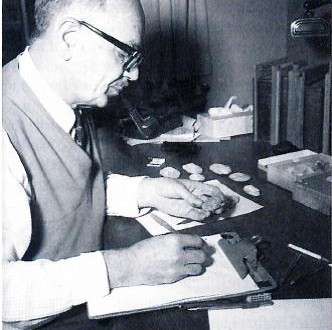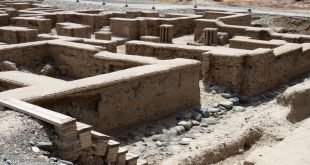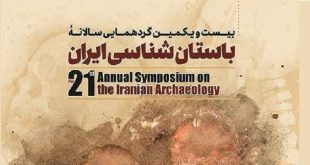لیلا مکوندی (دانشگاه کاشان)
در چهارم مارچ ۱۹۳۳ میلادی (۱۴ اسفند ۱۳۱۲ خورشیدی) جیمز هنری بریستد رئیس وقت موسسه شرق شناسی شیکاگو تلگرامی با این مضمون از ارنست هرتسفلد سرپرست کاوش تخت جمشید دریافت کرد:
“صدها، شاید هزارها متن تجاری عیلامی از صفه بدست آمد.”
تلگراف ارنست هرتسفلد (Stolper 2017: XXXVII)
از لابهلای همین چند کلمه نیز به خوبی می توان هیجان هرتسفلد را از این کشف مهم را دریافت. الواح بنابر یادداشت های هرتسفلد در دو اتاق کوچک آرشیو به صورت اتفاقی هنگام خاک برداری کارگران جهت ریل گذاری در دو اتاق کوچک در ضلع شمال شرقی تخت جمشید در بخش بارویی آن کشف شد و به همین دلیل “بایگانی باروی تخت جمشید” نام گرفت. هرتسفلد از کاوش در محل بایگانی بارو ۲۳ قطعه عکس تهیه کرد که دو عکس از این مجموعه توسط توسط موسسه شرق شناسی شیکاگو منتشر شده که نشان می دهند چند پله به فضای داخلی اتاقک ها راه داشت و در داخل آن انبوهی از تابلت های گلی سالم و شکسته بر روی یکدیگر انباشته شده بودند.
ورودی اتاقَهای زیرزمینی محل کشف تابلت ها (Garrison & Root , 2001, 29)
گلنوشته های بارو در محل کشف (Garrison, 2007, 1)
کاوش در محل کشف الواح حدود ۴ ماه و و بنا بر یادداشت های دفتر خاطرات کرفتر آخرین تابلت ها در ۲۵ ژوئن سال ۱۹۳۳ (اوایل تیرماه ۱۳۱۳ خورشیدی) ادامه یافت .(Henkelman 2008: 71) بنابراین در مجموعه کاوش در محل بایگانی بارو ها تقریبا حدود چهار ماه طول کشیده است.
ارنست هرتسفلد در حال ارائه توضیح درباره کاوش در تخت جمشید در بازدید رضا شاه سال ۱۹۳۲میلادی از تخت جمشید (Stolper 2017: XLIII)
مقرر شد تا بایگانی برای خوانش متن الواح و مطالعه به موسسه شرق شناسی شیکاگو برده شود. هیئت حفاری پس از آزادسازی گلنوشتهها برای حفاظت، قبل از اینکه خاک گلنوشتهها را پاک کنند آنها را با پارافین آغشته کردند. سپس آنها را در۲۳۵۳جعبه (جعبه های زیادی شامل قطعات شکسته بود) ترکیبی از گلنوشتههای با اندازه های مختلف بسته بندی کرده و در سال ۱۹۳۵ برای مطالعه به موسسه شرق شناسی شیکاگو منتقل کردند.
از سال ۱۹۳۷ میلادی تیمی ۴ نفره به سرپرستی آرنو پوبل با همکاری جورج کامرون، پیر پوروز و ریچارد هلوک کار مطالعه و خوانش الواح را آغاز کردند که حاصل کار آنها خوانش ۱۵۴ لوح بود. پس از مدتی ریچارد هلوک به تنهایی مطالعه متن های بایگانی بارو را به جز وقفه ای کوتاه در زمان جنگ جهانی دوم تا واپسین روزهای عمرش در ۱۹۸۰ میلادی ادامه داد. حاصل حدود ۴۰ سال پژوهش هلوک خوانش حدود ۴۸۰۰ متن عیلامی- هخامنشی بود که ۲۰۸۷ متن در سال ۱۹۶۹ منتشر و ۳۳ متن به صورت جداگانه در مقاله ای در ۱۹۷۸ منتشر گردید. با وجود اینکه هلوک سال ها به تنهایی بر روی این مجموعه کار کرد اما معتقد بود که “هیچ شخصی به تنهایی نمی تواند این متن ها را مطالعه کند و کار بر روی آنها نیازمند همکاری افراد بسیاری با تخصص های مختلف است” (Hallock, 1960: 90). با درگذشت هلوک در سال ۱۹۸۰ میلادی برای مدتی پژوهش های دانشگاه شیکاگو بر روی این مجموعه متوقف گردید تا اینکه از سال ۲۰۰۴ میلادی متیو استالپر در موسسه شرق شناسی شیکاگو تیمی از پژوهشگران علاقمند در حوزه خوانش متون عیلامی- هخامنشی، خط آرامی و پژوهشگران تاریخ هنر و باستانشناس را گرد هم آورد و پروژه مهم PFA مخفف بایگانی بارو تخت جمشید (Persepolis Fortification archive) آغاز به کار کرد.
ریچارد هلوک در حال خواندن متن ها (Stolper 2017: XLVII)
با آغاز دعوی حقوقی بر سر این بایگانی و ترس از اینکه رای دادگاه به ضرر مجموعه باشد، موسسه شرق شناسی شیکاگو و متیو استالپر علاوه بر اینکه با جدیت در دادگاه حاضر و از حفظ مجموعه و تعلق آن به ایران دفاع کردند، پروژه PFA نیز با جدیت بیشتری مطالعه و مستند نگاری الواح را دنبال کرد. خوشبختانه پس از بیش از ده سال رای نهایی دادگاه استیناف در اواخر فوریه ۲۰۱۸ (اسفند ماه ۱۳۹۵) به سود حفظ مجموعه و ایران صادر شد. رایی که موجب مسرت بسیار پژوهشگران در عرصه ملی و بین المللی گردید که ترس پراکنده شدن مجموعه را داشتند.
گزیده کتابشناسی بایگانی باروی تخت جمشید
Aperghis, G. G. (1996), “Travel Routes and Travel Stations from Persepolis.”, M.A. Thesis, University of London.
– (۱۹۹۷), “Surplus, Exchange and Price in the Persepolis Fortification Texts.” In J. Andreau, P. Briant, R. Descat eds., Economie antique. Prix et formation des prix dans les economies antiques. Entretiens d’archdologie et d’histoire (Saint- Bertrand-de-Comminges:M us6e archeologique d6partmental), pp. 277-290.
– (۱۹۹۸), “The Persepolis Fortification Texts-Another Look.” In M. Brosius and A. Kuhrt eds., Aspects of Achaemenid History: Essays in Memory of D.M. Lewis, Leiden: Nederlands Instituut voor het Nabije Oosten, pp. 35-62.
– (۱۹۹۹), “Storehouses and Systems at Persepolis: Evidence from the Persepolis Fortification Tablets”, Journal of the Economic and Social History of the Orient, Vol. 42, No. 2, pp.152-193.
– (۲۰۰۰), “War captives and economic exploitation: Evidence from the Persepolis Fortification Tablets”, in: J. Andreau, P. Briant & R. Descat (eds.), La guerre dans les economies antiques (Entretiens d’Archéologie et d’Histoire Saint-Bertrand-de-Comminges 5), Saint- Bertrand-de-Comminges: 127-144.
Azzoni, A. (2008), “The Bowman and The Aramic Tablets”, in L’archive des Fortifications de Persépolis. État des questions et perspectives de recherches. Paris., P. Briant; W. Henkelman & M. Stolper (eds.), (Persika 12), Paris: De Boccard: 253-236.
Azzoni, A & Stolper M. W, (2015), “From the Persepolis Fortification Archive Project, 5. The Aramaic Epigraph ns(y)ḥ on Elamite Persepolis Fortification Documents.” Achaemenid Research on Texts and Archaeology 2015.004.(http://www.achemenet.com/pdf/arta/ARTA_2015.004-Azzoni-Stolper.pdf)
Basello, G. P. – (2011), “Elamite Administrative Language from Susa to Persepolis”, in, Elam and Persia, J, Alvarez- Mon & M. Garrison (eds.), Winona Lake: 61- 88.
Briant, P., Henkelman, W.F.M., and Stolper, M.W., eds. (2008), L’archive des Fortifications de Persépolis. État des questions et perspectives de recherches. Paris.
Brosius, M. (1996), Women in Ancient Persia (559- 331), Oxford.
– (۲۰۰۳), “Reconstructing an Archive: Account and Journal Texts from Persepolis”, in Ancient Archives and Archival Traditions, M, Brosius (eds.), Oxford.
Dusinberre, E.R.M. (2008), ‘Seal impressions on the Persepolis Fortification Aramaic tablets: preliminary observations’, in L’archive des Fortifications de Persépolis. État des questions et perspectives de recherché, P. Briant, W. Henkelman and M. Stolper, (eds.), Paris: 239-252.
Garrison, M.B. (1988), Seal Workshop and Artists in Persepolis: a Study of Seal Impressions Preserving the Theme of Heroic Encounter on the Persepolis Fortification and Treasury Tablets, PhD Dissertation, University of Michigan (UMI 8907034), Ann Arbor.
– (۱۹۹۱), “Seals and the Elite at Persepolis: some Observations on Early Achaemenid Persian Art”, Ars Orientalis 21: 1- 29.
– (۱۹۹۶), ‘A Persepolis Fortification Seal on the Tablet MDP 11 308 (Louvre Sb 13078)’, Journal of Near Eastern Studies 55: 15-35.
– (۱۹۹۸), “The Seals of Ašbazana (Aspathines):, in Studies in Persian History. Essay of Memory of David M. Lewis, M. Brosius & A. Kuhrt (eds.), Achamenid History XI, Leiden: 115- 131.
– (۲۰۰۰), ‘Achaemenid Iconography as Evidenced by Glyptic Art: Subject Matter, Social Function, Audience and Diffusion’, in Images as Media: Sources for the Cultural History of the Near East and the Eastern Mediterranean (1st Millennium BCE). C. Uehlinger, (eds.), Fribourg – Göttingen: 115-163.
– (۲۰۰۶), “The Late Neo- Elamite Glyptic Style: A Perspective from Fars, Bulletin of the Asia Institute 16: 65- 102.
– (۲۰۰۸), ‘The uninscribed tablets from the Fortification archive: a preliminary analysis’, in L’archive des Fortifications de Persépolis. État des questions et perspectives de recherché, P. Briant, W. Henkelman and M. Stolper, (eds.), Paris: 149-238.
– (۲۰۰۹), ‘Visual Representation of Deities and Demons in Early Achaemenid Iran: Old Problems, New Directions’, www.religionswissenschaft.uzh.ch/idd/prepublication.php; accessed 08/12/2010; to be printed in Uehlinger and Graf, eds].
– (۲۰۱۱a), “The Seal of ‘Kuraš Anšanite, son of Šešpeš’ (Teispes), PFS 93: Susa- Anšan- Persepolis, in Elam and Persia, J. Alvarez- Mon & M. Garrisom (eds.), Winon Lake: 375- 406.
– (۲۰۱۱b) “By the Favor of Auramazdā: Kingship and the Divine in the Early Achaemenid Period.” In More than Men, Lessnthan Gods: Studies on Royal Cult and Imperial Worship; Proceedings of the International Colloquium Organized by the Belgian School at Athens (November 1–۲, ۲۰۰۷), P. P. Iossif, A. D. Chankowski, and C. C. Lorber (eds.) Studia Hellenistica 51. Leuven: Peeters, pp. 15– ۱۰۴٫
– (۲۰۱۳), “Royal Achaemenid Iconography.” In Oxford Handbook of Iranian Archaeology, Daniel T. Potts (eds.), Oxford: Oxford University Press, pp. 566–۹۵٫
– (۲۰۱۴a), “The Royal-Name Seals of Darius I.” In Extraction and Control: Studies in Honor of Matthew W. Stolper, Michael Kozuh, Wouter F. M. Henkelman, Charles E. Jones, and Christopher Woods (eds.), Chicago: The Oriental Institute, pp. 67–۱۰۴٫
- (۲۰۱۴b), “Glyptic Studies as Art History.” In Critical Approaches to Ancient Near Eastern Art, Brian A. Brown and Marian H. Feldman (eds.), Berlin: de Gruyter, pp. 481–۵۱۳٫
- (۲۰۱۷a), “Beyond Ahuramazda and the Winged Symbol: Imagery of the Divine and Numinous at Persepolis.” In Persian Religion in the Achaemenid Period/ La religion perse à l’époque achéménide, Wouter F. M. Henkelman Henkelman and Céline Redard eds.), Classica et Orientalia 16. Wiesbaden: Harrassowitz, pp. 185-246.
- (۲۰۱۷b), “Sealing Practice in Achaemenid Times.” In The Administration of the Achaemenid Empire: Tracing the Imperial Signature; Celebratory Conference on the Occasion of the 80th Anniversary of the Discovery of the Persepolis Fortification Archive, Wouter F. M. Henkelman and Bruno Jacobs (eds.), Basel, pp 517- 580.
Garrison, M.B., and Root, M.C. (1998), Persepolis Seal Studies. An Introduction with Provisional Concordances of Seal Numbers and Associated Documents on Fortification Tablets 1-2087. Leiden [updates on www.achemenet.com].
– (۲۰۰۱), Seals on the Persepolis Fortification Tablets, part 1: Images of Heroic Encounter, 2 vols. Chicago.
Garrison, M. B., and Robert K. R. (2010), “Seals Bearing Hieroglyphic Inscriptions from the Persepolis Fortification Archive.” Achaemenid Research on Texts and Archaeology 2010.002. http://www.achemenet.com /document /200.002 – Garrison&Ritner.pdf.
Giovinazzo, G. (1987), “Le Vin šap dans les Tablettes de Perseopolis”, Akkadika 63: ۱۲- ۲۶٫
– (۱۹۸۹), “Presence Babylonienne dan les Textes Economiques de Persepolis”, Annali dell Instituto Universitario Orientale di Napoli 49: 18- 127.
– (۱۹۹۳), “Les Šaumarraš dans les Textes de Persepolis”, Annali dell Instituto Universitario Orientale di Napoli 53: 121- 127.
– (۱۹۹۴a), “Les Documets de Voyage dans les Textes de Persepolis”, Annali dell Instituto Universitario Orientale di Napoli 54: 18- 31.
– (۱۹۹۴b), “Les Voyages de Darius dans les Regions Orientales de l Empire”, Annali dell Instituto Universitario Orientale di Napoli 54: 32- 45.
– (۱۹۹۵), “I puhu nei testi di Persepoli. Nouve In terpetationi”, Annali dell Instituto Universitario Orientale di Napoli 55: 141- 157.
– (۲۰۰۰/ ۲۰۰۱), “Les Indiens á Suse”, Annali dell Instituto Universitario Orientale di Napoli 60/ 61: 59- 76.
Hallock, R, (1969), Persepolis Fortification Tablets (OIP 92), Chicago.
Hallock, R. T. 1978, Selected Fortification Texts, CDAFI 8: 109-136.
Handley- Schachler, M. (1998), “The lan Ritual in the Persepolis Fortification texts” in Studies in Persian History. Essay of Memory of David M. Lewis, Achamenid History XI, M. Brosius & E. Kuhrt (eds.), Leiden: 195- 204.
Henkelman, W. F. M. (1995/96), ‘The Royal Achaemenid Crown’, Archäologische Mitteilungen aus Iran 28: 275-293.
– (۲۰۰۰a), review of M. –F. Brosius, Women in ancient Persia (559-331 BC) (Oxford 1996), Mnemosyne 53.4: 497-504.
– (۲۰۰۰b), Problems and possibilities of a Persepolis Fortification database [lecture held on 15/XII/2000 at the symposium Histoire achéménide et bases de données sur Internet at the Collège de France, Paris; see //www.achemenet.com/pdf/colloque/resumes.pdf].
– (۲۰۰۲), Exit der Posaunenbläser: On lance-guards and lance-bearers in the Persepolis Fortification archive, Achaemenid Research on Texts and Archaeology [see //www.achemenet.com/bookmark.do?link=arta-contents] 2002.007 [//www.achemenet.com/ressources/enligne/arta/pdf/2002.007.pdf].
– (۲۰۰۳a), ‘Persians, Medes and Elamites: Acculturation in the Neo-Elamite period’, in: Continuity of Empire: Assyria, Media, Persia, G. B, Lanfranchi, M, Roaf and R, Rollinger, (eds.), Padova: 181–۲۳۱, pls. 9–۱۵٫
– (۲۰۰۳b), ‘Defining “Neo-Elamite History”’, Bibliotheca Orientalis 60: 251-263.
– (۲۰۰۳c), ‘An Elamite Memorial: the šumar of Cambyses and Hystaspes’, in Henkelman and Kuhrt, eds., 101-172.
– (۲۰۰۵a), Zappan and zabar (“copper, bronze”) in Elamite, Nouvelles assyriologiques bréves et utilitaires [see also //achemenet.com/bookmark.do?link=nabu] 2005/24.
– (۲۰۰۵b), Animal sacrifice and ‘external’ exchange in the Persepolis Fortification Tablets, in H. D. Baker & M. Jursa (eds.), Approaching the Babylonian Economy: Proceedings of the START Project Symposium Held in Vienna, 1-3 July 2004 (Studies in the Economic History of First Millennium Babylonia 2 = Alter Orient und Altes Testament, Kevelaer- Neukirchen- Vluyn 330), Münster: 137-65.
– (۲۰۰۷a), s. v. Rakkan, in: Reallexikon der Assyriologie 11, Berlin- New York: 232- 233.
– (۲۰۰۷b), ‘Ruhurater’, Reallexikon der Assyriologie 11.5/6: 449.
– (۲۰۰۸a), The Other Gods Who Are: Studies in Elamite-Iranian Acculturation Based on the Persepolis Fortification Texts. Leiden.
– (۲۰۱۰), “Consumed before the King.” The Table of Darius, that of Irdabama and Irtaštuna, and that of his satrap, Karkiš’, in Der Achämenidenhof / The Achaemenid Court, B, Jacobs and R, Rollinger, (eds.), Wiesbaden: 667-775.
– (۲۰۱۱), “Parnakka’s Feast: šip”, in Pārsa and Elam’, Álvarez-Mon and Garrison, eds., 89-166.
– (۲۰۱۲), Une religion redistributive, Les sacrifices perses selon l’archive des Fortifications de Persépolis, Religions & Histoire 44: 36-41.
– (۲۰۱۳a), s.v. Persepolis Tablets, in: R.S. Bagnall et al. (eds.), The Encyclopedia of Ancient History, Chichester: 5179–۵۱۸۱٫
– (۲۰۱۳b), Administrative realities: The Persepolis archives and the archaeology of the Achaemenid heartland, in: D.T. Potts (ed.), The Oxford Handbook of Iranian Archaeology, Oxford: 528-46.
(۲۰۱۷a), “Humban and Auramazdā: Royal Gods in a Persian Landscape.” In Persian Religion in the Achaemenid Period/ La religion perse à l’époque achéménide, Wouter F. M. Henkelman and Céline Redard (eds.), Classica et Orientalia 16. Wiesbaden: Harrassowitz, pp. 273-346.
(۲۰۱۷b), Imperial Signature and Imperial Paradign: The Persepolis Archives and the Persian Empire, in: W.F.M. Henkelman & B. Jacobs (eds.), The Administration of the Achaemenid Empire – Tracing the Imperial Signature (Classica et Orientalia); Wiesbaden, pp 45- 256.
Henkelman, W.F.M., Jones, C.E., and Stolper, M.W. (2004), Clay tags with Achaemenid Seal Impressions in the dutch Institute of the Near East (NINO) and Elsewhere, Achaemenid Research on Texts and Archaeology [see //www.achemenet.com/bookmark.do?link=arta-contents] 2004.001 [//www.achemenet.com/ressources/enligne/arta/pdf/2004.001/2004.001.pdf].
– (۲۰۰۶), ‘Achaemenid Elamite Administrative Tablets, 2: The Qaṣr-i Abu Naṣr Tablet’, ARTA 2006.003.
Henkelman, W. F. M. & Kleber, K. (2007), Babylonian Workers in the Persian Heartland: Palace Building at Matannan during the Reign of Cambyses , in: C. Tuplin (ed.), Persian Responses. Political and Cultural Interaction with(in) the Achamenid Empire, Swansea: 163-76.
Henkelman, W. F. M. & Stolper, M. W. (2012), Ethnicity and Ethnic Labelling at Persepolis: the Case of the Skudrians, in P. Briant & M. Chauveau (eds.), Organisation des pouvoirs et contacts culturels dans les pays de l ’empire achéménide (Persika), Paris.
Henkelman, Wouter F. M. & Céline Redard, (2017), Persian Religion in the Achaemenid Period/ La religion perse à l’époque achéménide. Classica et Orientalia 16. Wiesbaden: Harrassowitz.
Hinz, W & Koch, H. (1978), Elamisches Wörterbuch, 2 vols. (Archäologische Mitteilungen aus Iran Erg Bd. 17), Berlin.
Jones, C. E. (1990), Document and Circumstance at the City of the Persians [unpublished paper presented at The First International Conference on the Ancient Cultural Relations between Iran and Western Asia, Tehran, August 16-18, 2003].
Jones, C.E., and Stolper, M.W. (1986), ‘Two Late Elamite Tablets at Yale’, in: De Meyer, Gasche and Vallat, eds., 243-254.
– (۲۰۰۸), “How Many Persepolis Fortification Tablets Are There”, in L’archive des Fortifications de Persépolis. État des questions et perspectives de recherché, P. Briant, W. Henkelman and M. Stolper, (eds.), Paris: 27- 49.
Kawase, T, (1980), “Sheep and Goats in Persepolis Royal Economy”, Acta Sumerologica Japonica 2: 37- 51.
– (۱۹۸۴), “Female Workers “pašap” in the Persepolis Royal Economy”, Acta Sumerologica Japonica 6: 19- 31.
Koch, H. (1977), Die religiösen Verhältnisse der Dareioszeit, Untersuchungen an Hand der elamischen Persepolistäfelchen (Göttinger Orientforschungen 3.4), Wiesbaden.
– (۱۹۸۳), Zu den Lohnverhältnissen der Dareioszeit in Persien, in: H. Koch & D.N. Mackenzie (eds.), Kunst, Kultur und Geschichte der Achämenidenzeit und ihr Fortleben (AMI Erg.Bd. 10), Berlin: 19-50.
-(۱۹۹۰), Verwaltung und Wirtschaft im persischen Kernland zur Zeit der Achämeniden (TAVO Beih. B89), Wiesbaden.
– (۱۹۹۲), Es kündet Dareios der König… Vom Leben im persischen Großreich, Mainz.
Lewis, D.M. (1994), The Persepolis Tablets: speech, seal and script, in: A.K. Bowman & G. Woolf (eds.), Literacy and power in the ancient world, Cambridge: 17-32
Maynhofer, M. (1973), Onomastica Persepolitana. Das altiranische Namengut der Persepolis Täfelchen (SBÖAW 286), Wien.
Potts, D. (۲۰۰۸), ‘The Persepolis Fortification texts and the Royal Road: another look at the Fahliyan area,’ in L’archive des Fortifications de Persépolis. État des questions et perspectives de recherché, P. Briant, W. Henkelman and M. Stolper, (eds.), Paris: 275-301.
Razmjou, S. (2004a), “The lan Ceremony and other Ritual Ceremonies in the Achamenid Period: the Persepolis Fortification Tablets”, Iran 42: 103- 117.
– (۲۰۰۴b), “Project Report of the Persepolis Fortification Tablets in the National Museum of Iran.” Achaemenid Research on Texts and Archaeology,2004.004.http://www.achemenet.com/ressources/nligne/arta/pdf/2004.004- Razmjou.pdf.
(۲۰۰۸), “Find Spots and Find Circumstances of Documents Excavated at Persepolis.” In L’archive des Fortifications de Persépolis: état des questions et perspectives de recherches, Pierre Briant, Matthew W. Stolper, and Wouter F. M. Henkelman (eds.), Persika 12. Paris: de Boccard. 2010 “Persepolis: A Reinterpretation, pp. 51–۵۸٫
Root, M.C. (۱۹۹۶), ‘The Persepolis Fortification Tablets. Archival Issues and the Problem of Stamp Versus Cylinder Seals’, in Boussac and Invernizzi, eds., 3-27.
– (۱۹۹۷), ‘Cultural Pluralisms on the Persepolis Fortification Tablets’, in Boussac, ed., 229-252.
– (۲۰۰۸), ‘The legible image: how did seals and sealing matter in Persepolis?’, in Briant, Henkelman and Stolper, eds., 87-147.
Steve, M.-J. (1992), Syllabaire élamite. Histoire et paléographie (Civilisations du Proche-Orient II.1), Neuchâtel – Paris.
Stolper, M. W, (1984), Texts from Tall-i Malyan, I: Elamite Administrative Texts (1972-1974) (Occasional Publications of the Babylonian Fund 6), Philadelphia.
– (۲۰۰۱), ‘Ganzabara’, Encyclopaedia Iranica 10: 286-289.
– (۲۰۰۴a), ‘Hidali’, Encyclopaedia Iranica 12: 308-309.
– (۲۰۰۴b), Elamite, in: R.D. Woodard (ed.), The Cambridge Encyclopedia of the World’s Ancient Languages, Cambridge: 60-94.
– (۲۰۰۴), Persepolis Fortification Archive Project. In The Oriental Institute 2006–۲۰۰۷ Annual Report, pp. 92–۱۰۳٫ The Oriental Institute of the University of Chicago, Chicago.
– (۲۰۰۵), Persepolis Fortification Archive Project. In The Oriental Institute 2006–۲۰۰۷ Annual Report, pp. 92–۱۰۳٫ The Oriental Institute of the University of Chicago, Chicago.
– (۲۰۰۶), Iranica in post-Achaemenid Babylonian Texts, in: P. Briant & F. Joannès (eds.), La transition entre l’empire achéménide et les royaumes hellénistiques (Persika 9), Paris: 223-60.
– (۲۰۰۶), Persepolis Fortification Archive Project. In The Oriental Institute 2006–۲۰۰۷ Annual Report, pp. 92–۱۰۳٫ The Oriental Institute of the University of Chicago, Chicago.
– (۲۰۰۷), Persepolis Fortification Archive Project. In The Oriental Institute 2006–۲۰۰۷ Annual Report, pp. 92–۱۰۳٫ The Oriental Institute of the University of Chicago, Chicago.
– (۲۰۰۸), The Persepolis Fortification Archive Project. In The Oriental Institute 2007–۲۰۰۸ Annual Report, pp. 110–۱۱۵٫ The Oriental Institute of the University of Chicago, Chicago.
– (۲۰۰۹), Persepolis Fortification Archive Project. In The Oriental Institute 2008–۲۰۰۹ Annual Report, pp. 104–۱۱۱٫ The Oriental Institute of the University of Chicago, Chicago.
– (۲۰۱۰), Persepolis Fortification Archive Project. In The Oriental Institute 2009–۲۰۱۰ Annual Report, pp. 83–۹۱٫ The Oriental Institute of the University of Chicago, Chicago.
– (۲۰۱۱), Persepolis Fortification Archive Project. In The Oriental Institute 2010–۲۰۱۱ Annual Report, pp. 102–۱۱۱٫ The Oriental Institute of the University of Chicago, Chicago.
– (۲۰۱۲), Persepolis Fortification Archive Project. In The Oriental Institute 2011–۲۰۱۲ Annual Report, pp. 145–۱۵۲٫ The Oriental Institute of the University of Chicago, Chicago.
– (۲۰۱۳), Persepolis Fortification Archive Project. In The Oriental Institute 2012–۲۰۱۳ Annual Report, pp. 105–۱۱۲٫ The Oriental Institute of the University of Chicago, Chicago.
– (۲۰۱۴), Persepolis Fortification Archive Project. In The Oriental Institute 2012–۲۰۱۳ Annual Report, pp. 105–۱۱۲٫ The Oriental Institute of the University of Chicago, Chicago.
– (۲۰۱۴), “Case in Point: the Persepolis Fortification Archive”, In Arcgaeologies of Texts: Archaeology, Technology and Ethics, Rutz, M& Kersel, M (eds.), London, Oxbow Books: 14- 30.
- (۲۰۱۵), Persepolis Fortification Archive Project. In The Oriental Institute 2012–۲۰۱۳ Annual Report, pp. 105–۱۱۲٫ The Oriental Institute of the University of Chicago, Chicago.
- (۲۰۱۶), Persepolis Fortification Archive Project. In The Oriental Institute 2012–۲۰۱۳ Annual Report, pp. 105–۱۱۲٫ The Oriental Institute of the University of Chicago, Chicago.
- (۲۰۱۷a), Persepolis Fortification Archive Project. In The Oriental Institute 2012–۲۰۱۳ Annual Report, pp. 105–۱۱۲٫ The Oriental Institute of the University of Chicago, Chicago.
- (۲۰۱۷b) “From the Persepolis Fortification Archive Project, 6. The Dossier of Šarbaladda, Treasury Secretary at Persepolis.” Achaemenid Research on Texts and Archaeology 001.
- (۲۰۱۷c), “Investigating Irregularities at Persepolis. In The Administration of the Achaemenid Empire: Tracing the Imperial Signature: Celebratory Conference on the Occasion of the 80th Anniversary of the Discovery of the Persepolis Archive, Wouter F. M. Henkelman and Bruno Jacobs (eds.), Basel, pp XXXVIII- LIX.
Stolper, M& Jones, Ch. (۲۰۰۸) How Many Persepolis Fortification Tablets Are There?, in: Les archives des Fortifications de Persépolis dans le contexte de l’Empire achéménide et de ses prédécesseurs, Actes du colloque organisé au Collège de France et au Centre de l’Université de Chicago à Paris, 3-4 Novembre 2006 (Persika 12), P. Briant, W.F.M. Henkelman & M.W. Stolper (eds.),Paris: 27- 49.
Tavenier, J. (2007), Iranica in the Achaemenid Period (ca. 550-330 B.C.). Lexicon of Old Iranian Proper Names and Loanwords, Attested in Non-Iranian Texts. Leuven – Paris.
– (۲۰۰۸), Multilingualism in the Fortification and Treasury Archives, in: Les archives des Fortifications de Persépolis dans le contexte de l’Empire achéménide et de ses prédécesseurs, Actes du colloque organisé au Collège de France et au Centre de l’Université de Chicago à Paris, 3-4 Novembre 2006 (Persika 12 ), P. Briant, W.F.M. Henkelman & M.W. Stolper (eds.),Paris: 59- 84.
Tuplin, C. (2008), “Taxation and Death. Certainties in the Persepolis Fortification Archive?, in: Les archives des Fortifications de Persépolis dans le contexte de l’Empire achéménide et de ses prédécesseurs, P. Briant, W.F.M. Henkelman, M.W. Stolper (eds.), Paris: 317- 385.
 انجمن علمی باستانشناسی ایران پورتال رسمی انجمن علمی باستانشناسی ایران
انجمن علمی باستانشناسی ایران پورتال رسمی انجمن علمی باستانشناسی ایران









